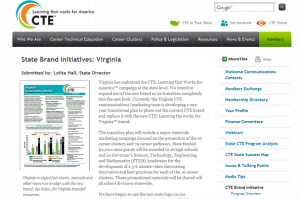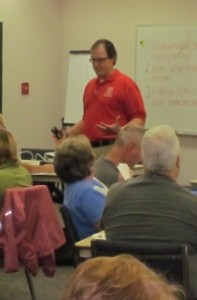 The 2012 Career Clustersâ„¢ Institute Call for Presenters is now open!
The 2012 Career Clustersâ„¢ Institute Call for Presenters is now open!
The Institute is June 18-20, 2012 in Washington, DC at the Omni Shoreham Hotel.
The Call for Presentations for the 2012 Career Clustersâ„¢ Institute is Now Open. You are cordially invited to submit a proposal. The purpose of the Institute is to provide a venue for sharing of effective practices, ideas, and research. Ultimately, the goal is to increase student success and ensure our nation’s economic growth and security. Therefore, Institute sessions should promote the use of Career Clustersâ„¢ to drive collaboration and innovation in state and local education and workforce systems.
The 2012 Institute theme is Setting a New Standard and the program will be organized into five primary strands. Share your experiences and successes to inform participants with specific how-to, replicable advice that goes beyond awareness of Career Clustersâ„¢ to specific implementation strategies.
Benefits for approved breakout sessions:
• Reduced registration at the conference for up to 3 presenters/breakout
• Opportunity to collaborate with colleagues from around the country
• Share practices and experiences to increase engagement and opportunity with others
• Professional development
• Highlight/showcase your topic, providing visibility at the national level
Strand Descriptions
Strand A: CTE is critical to ensuring that the United States leads in global competitiveness.
Sessions in this strand will share examples (state, local and regional) of leaders in education (secondary and postsecondary), workforce development, economic development and/or business work together to increase U.S. investment in CTE, updates on the creation of a common career technical core, built upon the National Career Clustersâ„¢ Knowledge and Skill Statements, and other policy focused best practices advancing efforts in secondary and postsecondary education systems.
Key areas of strand focus:
• State Policy Development and Implementation
• Federal Policy Implementation
• Marketing and Communication Strategies Approaches
Strand B: CTE actively partners with employers to design and provide high-quality, dynamic programs.
Sessions in this strand will share examples (state, local and regional) where leaders in education (secondary and postsecondary), workforce development, economic development and/or business work together for shared interests and goals using Career Clustersâ„¢ as the unifying model/approach.
Key areas of strand focus:
• Examples of Collaboration
• Workforce Development
• Economic Development
• Partnership Development
• Using data to inform program decisions
• Professional Development Strategies
• Industry trends
Strand C: CTE prepares students to succeed in further education and careers.
Sessions in this strand are targeted for leaders at the state, district and local levels in secondary and postsecondary settings. Sessions will provide practical advice, examples and resources to support College and Career Readiness and to expand/enrich current implementation of Career Clustersâ„¢. Session may include a focus on how Career Clustersâ„¢ align initiatives and improvement efforts, the impact of Career Clustersâ„¢ on curriculum, guidance and/or community engagement activities in the school.
Key areas of strand focus:
• School and Career Counseling Approaches
• Career Development and Exploration Resources
• Integrating Educational Subjects (e.g., Math and CTE, etc.)
• Common Core State Standard Integration
• Reducing Remediation and Improving Transition
Strand D: CTE is delivered through comprehensive programs of study aligned to the National Career Clustersâ„¢ framework.
Sessions in this strand will share examples of the impact Career Clusters’™ innovative teaching and learning strategies can have in shaping programs of study and career technical education efforts in secondary schools and postsecondary systems. Strategies also may include delivery and innovative implementation approaches around specific Career Cluster™ areas.
Key areas of strand focus:
• Career Clusters™ Implementation
• Teaching and Learning Innovations and Strategies
• Use of Standards, Knowledge and Skills, Competencies
• Programs of Study Development/Refinement
• CTE Delivery Systems and approaches (including Career Academies, Model Schools, and other approaches)
Strand E: CTE is a results-driven system that demonstrates a positive return on investment.
Sessions in this strand will share examples (state, local, and regional) that exhibit high quality, successful, scalable CTE practices, share models that demonstrate CTE’s positive fiscal, societal, and economic impact, and show how data (secondary and postsecondary) is successfully used (state, local and regional) to support CTE accountability measures.
Key areas of strand focus:
• Accountability and Evaluation
• Technical Skill Assessments
• Research based Approaches and Studies
• Return on Investment Approaches
Complete the Call for Presentation information form online today!
More information about the Institute
Questions? Call our office at 301-588-9630.
Ramona Schescke, Member Services Manager







